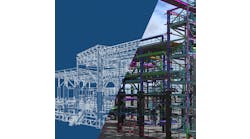Some North American utilities watch 45% or more of their water go down the drain as “unaccounted-for water.” Although Halifax (Nova Scotia) Regional Water Commission has lost only half that amount in recent years, it was still too much for this conscientious utility. That’s why the Halifax team took aim at unaccounted-for water, and it now has successfully engaged large commercial and industrial customers in the battle as well. How? By connecting C&I customer meters to the utility’s supervisory control and data acquisition (SCADA) system. Now the utility is looking to catch big leaks before the water spills into the ocean, saving money for the utility and its customers.
Night vision shows trouble spots
As the first utility in North America to adopt the International Water Association’s formal approach to leakage measurement, Halifax has taken an impressively strategic approach to water accountability since the mid-1990s.
“We hate the expression unaccounted-for water,” Carl Yates, the utility’s general manager, said. “So we started using our SCADA system to monitor nighttime flows in an effort to understand consumption patterns and identify potential problems.”
But monitoring the SCADA system only left the utility chasing phantom leaks and breaks.
“We’d be watching the system, and suddenly the flows would pick up. At night, you really notice it,” Yates said. “We’d send out leak crews and find nothing. Then, when we checked meter consumption, we’d realize we’d been selling that water all along. With very large customers working around-the-clock shifts, you can see huge water consumption all night long.”
Like most utilities, Halifax is happy to be selling its water any time of the day, but because meters weren’t connected to the SCADA system, the utility was wasting time and people on leak reconnaissance.
“We were probably spending a week per month looking for leaks when we’d see these unusual flows,” Yates said. “That translates to about $4,000 monthly, plus aggravation and liability of having crews out.”
“If we could connect the meters with the SCADA system, we’d know when flows were actual usage, not leaks,” he added.
To defray costs of the upscale AMR units that would measure C&I customer usage on a continuous basis, the utility pitched the program to the customers themselves. The result? “Customers like this program so much that they’re willing to share the cost with us 50/50,” Yates said.
Shared costs bring shared returns
For large industrial customers paying as much as one dollar per cubic meter, the partial cost of AMR isn’t nearly as high as the potential risk of undetected leaks.
“An 8-in. main can flow 1,000 gallons a minute,” Yates said. “If a leak goes undetected on a weekend, you could lose three million gallons. That’s roughly 13,000 cubic meters or $13,000 that you leaked away in two days.”
The utility saves, too. Along with cutting hours wasted looking for possible leaks that are actually consumption, the high-powered SCADA system endpoints help the utility efficiently monitor its distribution network.
“The data we’re capturing is valuable for hydraulic modeling and determining infrastructure investments,” Yates added. “It allows us to better understand and improve flow patterns in the system.”
Another boon to the utility’s aggressive leak management is delay of capital investments such as dam building and system upgrades.
“Since 1996, we’ve found five million gallons a day in leakage,” Yates said. “That could postpone upgrades to the system for as long as 10 years or more. And when we keep production down, we cut costs at the treatment plant. It’s good stewardship of a precious natural resource.”


